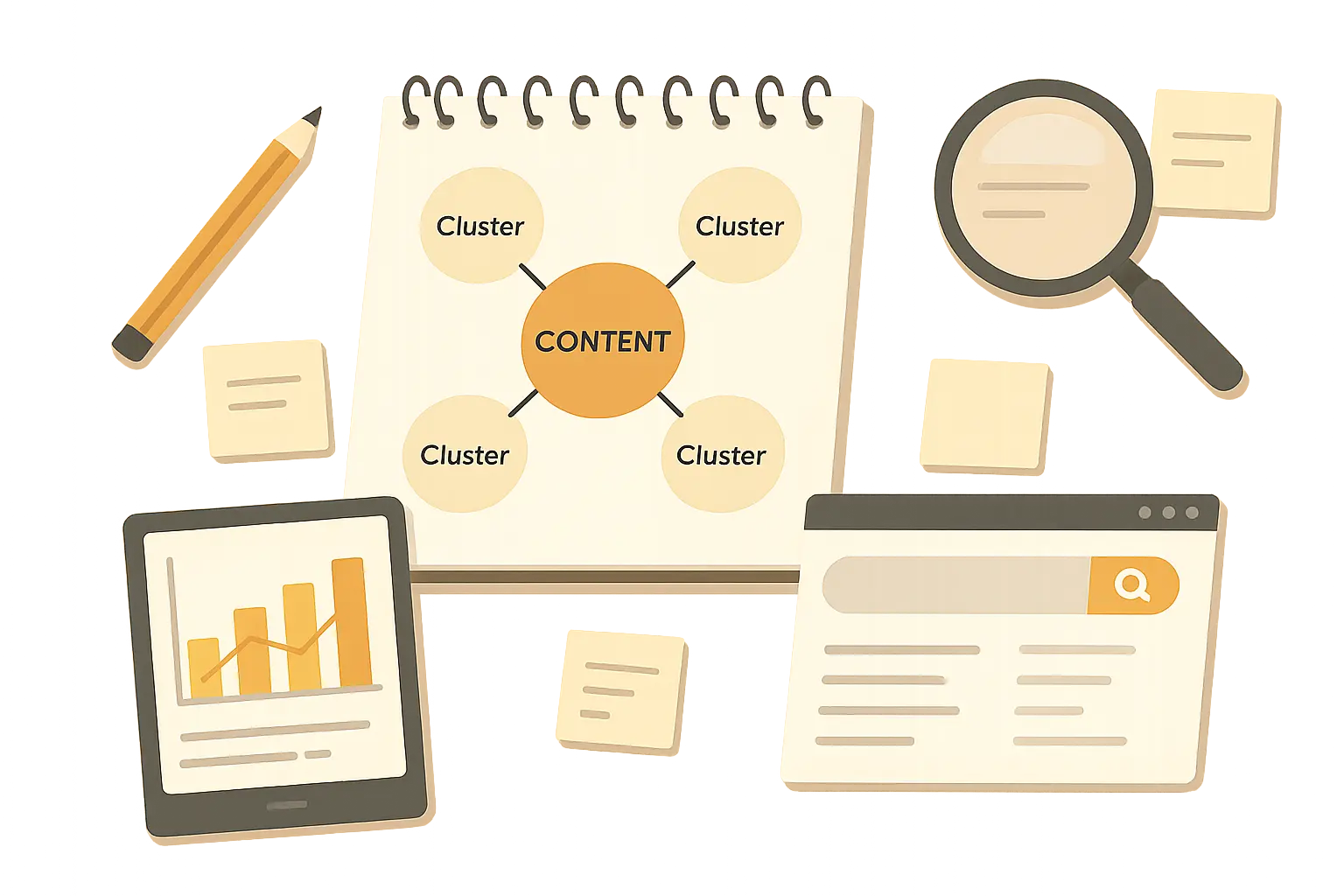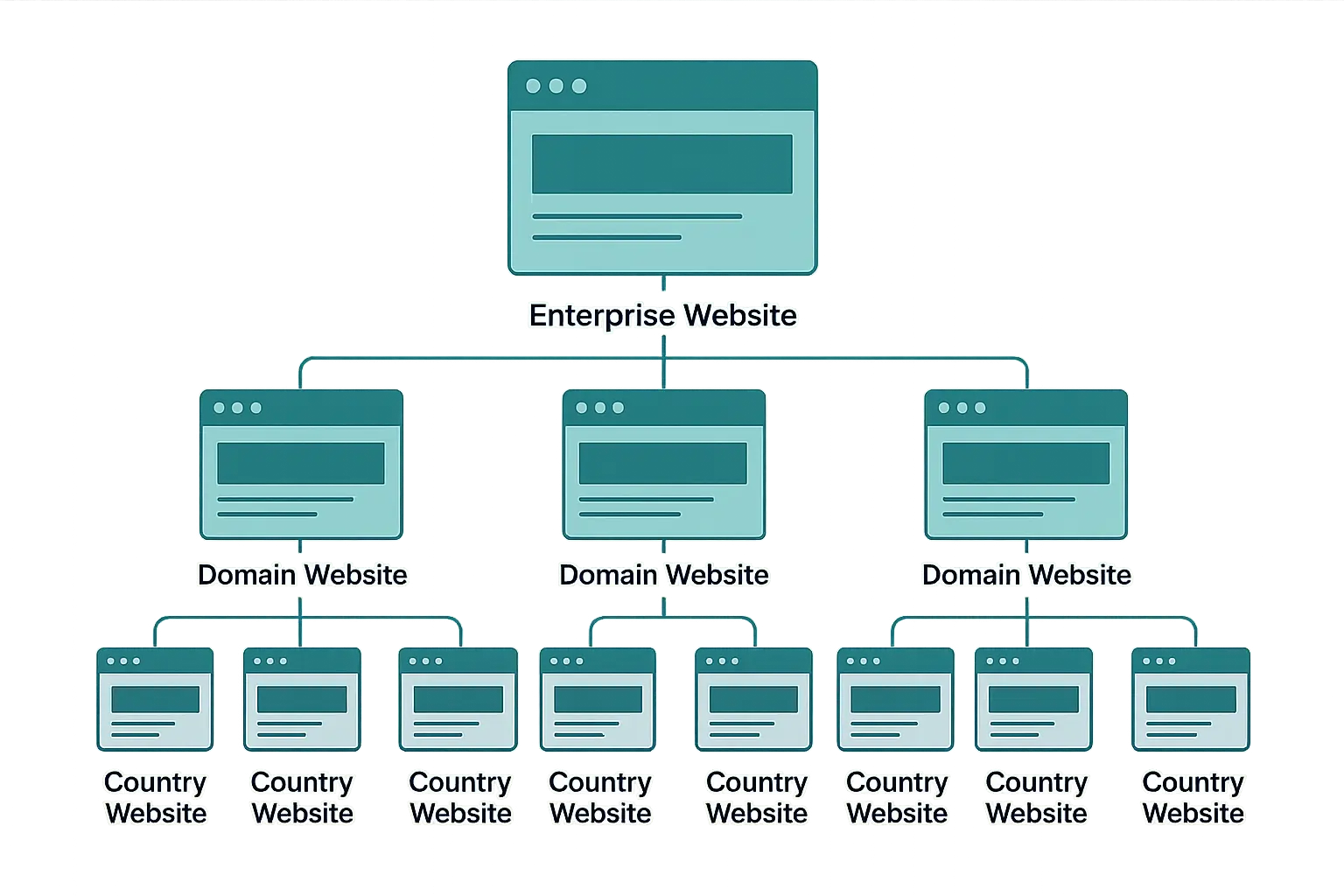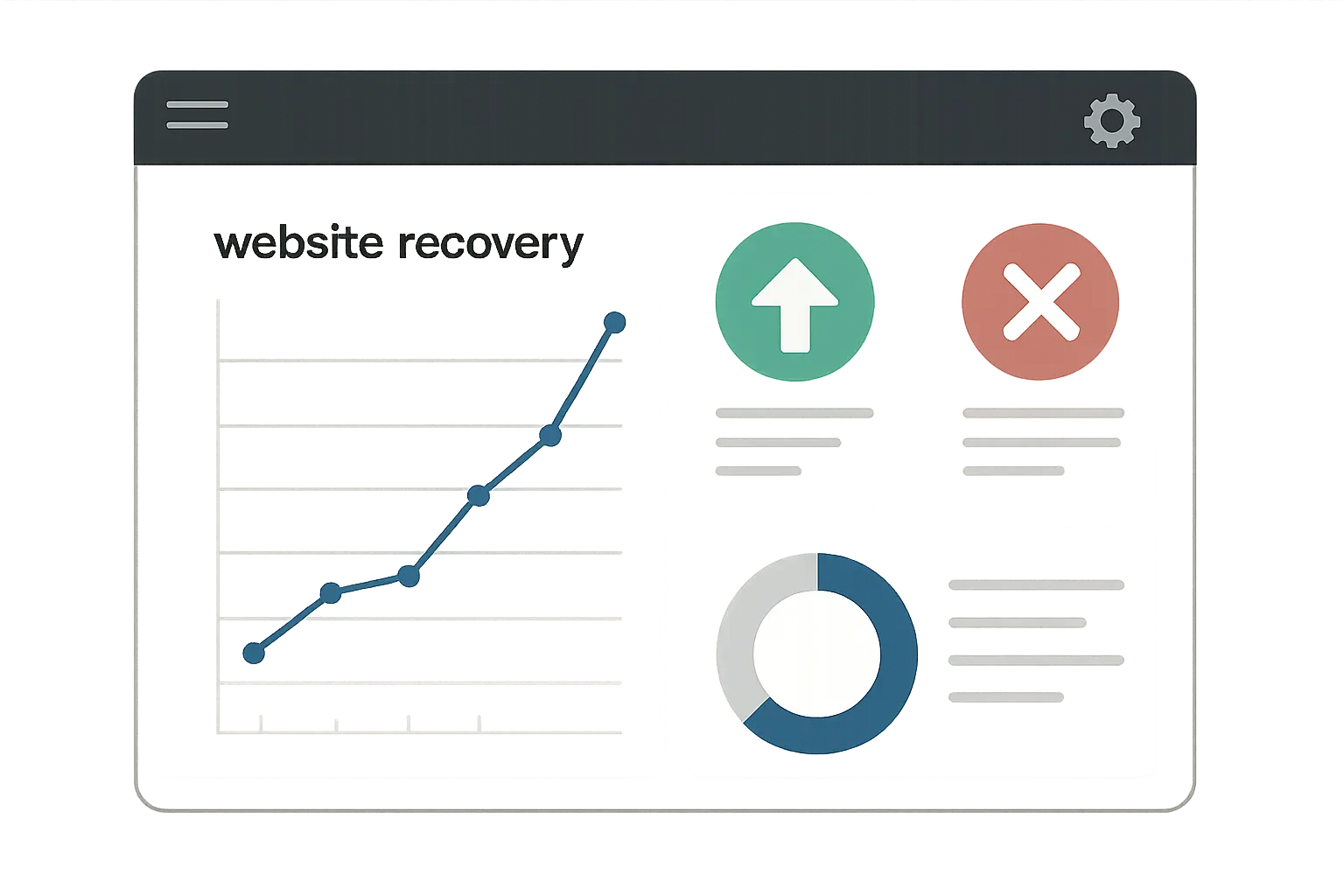Okay, so I’m knee-deep in Google Analytics last Tuesday (don’t judge me for working late), and I see this stat that literally made me spit out my coffee. According to AIOSEO’s latest research, SEO case studies are the ultimate way of finding out what works (and what doesn’t) to climb search results. It reminded me of all the times I’ve wasted money on tactics that sounded brilliant in theory but face-planted in reality.
You know that soul-crushing feeling when you’re implementing strategy after strategy, but your organic traffic stays flatter than a pancake? Yeah, I’ve been there. Multiple times. The “build 1000 backlinks in 30 days” phase of my career? We don’t talk about that.
That’s exactly why I dove deep into 25 real-world SEO success stories that cut through all the BS and show you what actually works. Not the theoretical stuff that sounds impressive in meetings, but documented cases with real numbers, messy timelines, and strategies you can actually steal… I mean, replicate.
These aren’t fairy tales or wishful thinking—they’re the real deal with screenshots, specific numbers, and honest admissions about what didn’t work. Whether you’re dealing with technical nightmares that make you want to cry, content that converts about as well as a chocolate teapot, or local SEO that’s going absolutely nowhere, there’s a roadmap here for you.

Table of Contents
-
How to Spot SEO Case Studies Worth Your Time
-
Technical SEO Transformations
-
1. E-commerce Site Speed Optimization
-
2. Mobile-First Indexing Recovery
-
3. JavaScript SEO for SPA
-
4. International SEO Restructure
-
-
Content Marketing SEO Wins
-
5. Blog SEO Transformation
-
6. Pillar Page Strategy Implementation
-
7. Video Content SEO Success
-
8. Long-tail Keyword Content Strategy
-
9. Content Gap Analysis Implementation
-
-
Local SEO Success Stories
-
10. Multi-Location Restaurant Chain
-
11. Professional Services Local Domination
-
12. Home Services SEO Overhaul
-
13. Medical Practice Local Authority Building
-
-
E-commerce SEO Case Studies
-
14. Product Page Optimization Strategy
-
15. Category Page SEO Transformation
-
16. E-commerce Content Marketing Integration
-
17. Marketplace SEO Recovery
-
-
Enterprise SEO Case Studies
-
18. Fortune 500 Website Migration
-
19. Enterprise Content Scaling
-
20. Multi-Brand SEO Consolidation
-
21. International Enterprise Expansion
-
-
Recovery and Penalty Case Studies
-
22. Google Penalty Recovery
-
23. Algorithm Update Recovery
-
24. Negative SEO Attack Recovery
-
25. Site Redesign Traffic Recovery
-
-
What Makes These Case Studies Actually Useful
-
How The Marketing Agency Can Help You Replicate These Results
TL;DR
-
Technical SEO fixes can deliver 67% page speed improvements and 45% traffic increases in just 4 months (when done right)
-
Content strategies that focus on topic clustering can generate 1,200% traffic growth within 12 months (patience required)
-
Local SEO optimization for multi-location businesses can increase visibility by 167% in 6 months (consistency is key)
-
E-commerce product page optimization drives 178% traffic increases with 34% better conversion rates (the sweet spot)
-
Enterprise website migrations can maintain zero traffic loss while improving performance by 45% (with proper planning)
-
Recovery from Google penalties is possible, with some sites achieving 189% growth beyond pre-penalty levels (it’s not hopeless)
-
The most successful case studies combine multiple SEO disciplines rather than relying on single tactics (no magic bullets)
-
Sustainable results require 6+ months of consistent work and ongoing optimization (sorry, no shortcuts)
How to Spot SEO Case Studies Worth Your Time
Before we dive into the good stuff, we need to talk about separating the wheat from the chaff. I’ve probably read through hundreds of “case studies” that were basically just fancy sales brochures with made-up numbers. You know the ones – “We increased traffic by 500%!” but they conveniently forget to mention they went from 10 visitors to 60 visitors. Cool story, bro.
Here’s what actually separates the legit stuff from the marketing BS:
Real numbers with context matter way more than flashy percentages. When I see a case study that says “grew from 5,000 to 20,000 monthly organic visitors over 8 months,” I can actually work with that. It tells me the scale, the timeline, and whether it’s relevant to my situation. They’ll include screenshots, mention the tools they used, and sometimes even provide Google Analytics exports.
If they won’t tell you how they did it, run. The best case studies make you feel like you’re getting a behind-the-scenes look at their entire process. If someone achieved amazing results but keeps the methodology “proprietary,” that’s usually code for “we got lucky and don’t know why.”
Business context is everything. I learned this the hard way when I tried to apply a Fortune 500 SEO strategy to a local plumber’s website. Spoiler alert: it didn’t work. Now I always check – does this business look like mine? Similar industry? Similar resources? Similar competition level?
Overnight success stories are usually BS. Real SEO takes time. Period. I’ve seen too many people get burned by promises of instant results. The legitimate cases show 3-12 month timelines because that’s reality. Anyone promising faster results is either lying or using tactics that’ll get you penalized later.
|
Red Flags That Make Me Cringe |
What Legit Case Studies Look Like |
|---|---|
|
“Increased traffic 500% overnight!” |
“Grew from 5K to 25K visitors over 8 months” |
|
“Secret proprietary method” |
Step-by-step methodology breakdown |
|
No mention of resources needed |
“Required 120 hours of dev work and $5K budget” |
|
Only shows peak performance |
Long-term tracking with ups and downs |
|
Vague industry mentions |
Specific business context and competition level |
|
Cherry-picked short-term data |
Long-term performance tracking |
The cases I’m sharing here? They pass the smell test. They show you the messy details, admit what didn’t work, and give you realistic expectations about time and resources.
Technical SEO Transformations
Technical SEO is like the foundation of your house – boring to think about, but everything falls apart without it. These four case studies show how fixing the unsexy stuff can deliver massive results within 3-8 months.

1. E-commerce Site Speed Optimization
The Challenge: This online retailer was bleeding visitors faster than a leaky bucket. Three-second page load times meant 40% of potential customers bounced before they even saw a product. Ouch.
The Strategy: They went all-in on Core Web Vitals optimization. Image compression using WebP format cut file sizes by 60%. Lazy loading meant product images only loaded when people actually scrolled to them (genius, right?). A CDN upgrade with 15 global edge locations brought content closer to users. CSS and JavaScript minification cleaned up years of code bloat. Database query optimization dropped server response time from a painful 800ms to a snappy 200ms.
The Results: Page speed improved by 67%, organic traffic jumped 45%, and conversions increased 23%. The whole transformation took 4 months and cost $3,500 – which paid for itself in about 6 weeks.
Why It Worked: Site speed directly impacts both user experience and search rankings. Google’s Core Web Vitals update made this even more critical. The systematic approach addressed every bottleneck rather than just slapping on a quick fix.
This technical seo case study demonstrates the importance of systematic technical SEO optimization that tackles multiple performance factors at once.
Here’s a real example of this in action: The retailer’s product pages initially took 3.2 seconds to load. After implementing WebP compression, lazy loading for below-the-fold images, and CDN optimization, the same pages loaded in 1.1 seconds. Customers stopped abandoning the site during loading, which directly led to that 23% conversion rate boost.
2. Mobile-First Indexing Recovery
The Challenge: A B2B software company got absolutely crushed when Google’s mobile-first indexing update hit their desktop-only site. They lost 60% of organic traffic overnight. I still remember the panicked phone call.
The Strategy: Complete responsive design overhaul that prioritized mobile users for once. Mobile UX optimization included touch-friendly navigation and fonts you could actually read without squinting. Structured data implementation helped search engines understand content on tiny screens. Page speed optimization specifically targeted mobile loading times.
The Results: Full traffic recovery plus 30% growth beyond previous levels within 6 months. Mobile organic traffic increased 150% year-over-year. The CEO literally sent champagne to the office.
Why It Worked: Google now primarily uses mobile versions of sites for indexing and ranking. Sites that provide terrible mobile experiences get penalized hard, while those that excel get rewarded. Simple as that.
3. JavaScript SEO for SPA
The Challenge: A React-based application had zero organic visibility because search engines couldn’t properly crawl the JavaScript-rendered content. It was like being invisible to Google.
The Strategy: Server-side rendering implementation using Next.js allowed search engines to see fully rendered pages instead of blank JavaScript files. Prerendering for the top 100 critical landing pages provided static HTML versions. Dynamic XML sitemaps helped search engines discover new content as it was created. Proper meta tag management ensured each page had unique titles and descriptions.
The Results: Indexed pages exploded from 50 to 2,000 (that’s a 400% improvement). Organic traffic grew 250% within 3 months. Total development time was 120 hours, but the ROI was massive.
Why It Worked: Search engines are getting better at JavaScript, but server-side rendering removes all uncertainty. It gives search engines the clean HTML they prefer while maintaining the slick user experience that modern apps require.
4. International SEO Restructure
The Challenge: A global brand had duplicate content issues across 15 countries, confusing search engines and diluting ranking potential. Different country sites were basically competing against each other.
The Strategy: Hreflang implementation told search engines which content served which geographic regions. Country-specific content strategy created unique value for each market instead of just translating everything. Technical consolidation eliminated duplicate pages while preserving regional relevance. URL structure optimization used subdirectories for different countries (/us/, /uk/, /de/, etc.).
The Results: International organic traffic increased 180%. Local rankings in target countries improved 45%. The project took 8 months to complete fully, but the results were worth it.
Why It Worked: International SEO requires technical precision. Proper hreflang implementation and unique content for each market signals to search engines that you’re providing genuine value rather than just copy-pasting content across domains.
Content Marketing SEO Wins
Content is still king, but strategy beats volume every single time. These five case studies show how smart content approaches can drive traffic growth from 78% to 1,200% within 4-12 months.

5. Blog SEO Transformation
The Challenge: This SaaS company was stuck at 5,000 monthly blog visitors despite publishing twice a week for over a year. Their content wasn’t ranking, leads weren’t coming in, and the marketing team was getting frustrated.
The Strategy: Keyword clustering methodology identified 500+ target keywords grouped by topic instead of random blog post ideas. Topic authority building focused on becoming the go-to resource for specific subjects rather than covering everything under the sun. Content optimization included proper title tags, meta descriptions, header structure, and strategic internal linking. A 52-week editorial calendar ensured consistent publishing with seasonal considerations.
The Results: Traffic exploded from 5,000 to 65,000 monthly visitors – that’s a 1,200% increase. Lead generation improved 300%. The transformation took 12 months of consistent execution, but the results speak for themselves.
Why It Worked: Topic clustering signals topical authority to search engines. Instead of competing against themselves with scattered content, they became THE resource for their industry topics. Google rewards depth and expertise.
This blog seo case study showcases how strategic blog topic selection combined with comprehensive keyword research can completely transform content performance.
6. Pillar Page Strategy Implementation
The Challenge: A marketing agency had quality content scattered all over their blog but couldn’t rank for the competitive terms that actually mattered to their business.
The Strategy: Topic cluster model organized content around central pillar pages that covered broad topics comprehensively. Supporting cluster content addressed specific subtopics and linked back to pillars, creating a web of topical authority. Internal linking optimization created clear content relationships. Content consolidation eliminated competing pages that were cannibalizing each other.
The Results: Organic traffic increased 89%. Average session duration improved 67% as users found more relevant, connected content. Implementation took 6 months of systematic organization.
Why It Worked: Pillar pages demonstrate deep expertise on broad topics while cluster content captures long-tail searches. The internal linking structure helps search engines understand content relationships and authority
Why It Worked: Pillar pages demonstrate deep expertise on broad topics while cluster content captures long-tail searches. The internal linking structure helps search engines understand content relationships and authority signals.
Here’s how this worked in practice: They created a comprehensive 5,000-word pillar page on “Digital Marketing Strategy” and supported it with 15 cluster pages covering specific tactics like “Email Marketing ROI” and “Social Media Analytics.” Each cluster page linked back to the pillar page, creating a web of topical authority that helped the pillar page rank #3 for “digital marketing strategy” within 4 months.
7. Video Content SEO Success
The Challenge: A fitness brand was creating amazing video content but getting terrible engagement and zero search visibility. All that production effort was basically wasted.
The Strategy: YouTube SEO optimization included keyword-rich titles, detailed descriptions, and custom thumbnails that actually got clicks. Video schema markup helped search engines understand video content on their website. Cross-platform content syndication distributed videos across multiple channels for maximum reach. Video transcripts provided searchable text content. Topic-based playlists organized content for better user experience and watch time.
The Results: Video views increased 340%. Website organic traffic from video sources grew 125%. The optimization took 4 months with 2 videos published weekly.
Why It Worked: Video content captures attention and engagement signals that search engines absolutely love. Proper optimization makes videos discoverable across multiple platforms and search results, maximizing the ROI on video production.
8. Long-tail Keyword Content Strategy
The Challenge: A local service business couldn’t compete against national chains for broad keywords like “plumbing services” but was missing tons of opportunities for specific local searches.
The Strategy: Hyper-local content creation targeted “service + location” combinations like “emergency plumbing Scottsdale” or “water heater repair Tempe.” Long-tail keyword targeting focused on specific problems customers actually searched for. FAQ optimization answered common customer questions in detail. Service area pages covered each geographic location they served. Customer review integration provided fresh, relevant content that search engines could index.
The Results: Local organic traffic increased 78%. Conversion rate improved 156% because the traffic was way more qualified – people searching for “emergency water heater repair Phoenix” are ready to buy. The strategy took 5 months to implement fully.
Why It Worked: Long-tail keywords have less competition and much higher conversion rates. Local businesses can absolutely dominate these searches by providing specific, relevant content that national competitors ignore or can’t match.
9. Content Gap Analysis Implementation
The Challenge: An e-learning platform was losing market share to competitors who seemed to rank for everything they couldn’t. It was frustrating watching competitors capture traffic they should have been getting.
The Strategy: Comprehensive competitor content analysis identified topics competitors covered that they completely missed. Gap identification revealed over 200 content opportunities they’d never considered. Strategic content creation prioritized high-impact topics first based on search volume and competition. Content quality standards ensured each piece provided unique value, not just keyword stuffing. Performance tracking measured which gap-filling content actually moved the needle.
The Results: Organic traffic increased 234%. Keyword rankings improved 45% across target terms. The 9-month project required significant content investment, but the ROI was clear.
Why It Worked: Competitor analysis reveals proven content opportunities that already have demonstrated demand. By systematically filling content gaps, they captured search traffic that competitors had been monopolizing for years.
|
Content Strategy Type |
Traffic Growth |
Implementation Time |
Best For |
|---|---|---|---|
|
Topic Clustering |
1,200% |
12 months |
SaaS/B2B companies |
|
Pillar Pages |
89% |
6 months |
Service-based businesses |
|
Video SEO |
125% |
4 months |
Visual/educational brands |
|
Long-tail Local |
78% |
5 months |
Local service businesses |
|
Gap Analysis |
234% |
9 months |
Competitive markets |
Local SEO Success Stories
Local SEO is a different beast entirely. You’re not just competing for rankings – you’re fighting for real foot traffic and phone calls. These four case studies show how businesses achieved 78% to 290% increases in local visibility and actual leads within 4-8 months.

10. Multi-Location Restaurant Chain
The Challenge: A 25-location restaurant chain had the most frustrating problem – some locations were killing it in local search while others were practically invisible. Same brand, same food, completely different results.
The Strategy: Google My Business optimization ensured consistent NAP (Name, Address, Phone) across every single location – no exceptions. Location-specific landing pages provided unique content for each restaurant instead of cookie-cutter templates. Local citation building included 150+ directories per location (yes, it was tedious). Review management system automated review requests and responses without sounding robotic. Local link building involved chamber memberships and community sponsorships.
The Results: Local search visibility increased 167% across all locations. Foot traffic grew 89% – and we’re talking actual butts in seats, not just website visits. The comprehensive approach took 6 months to implement fully.
Why It Worked: Consistency is everything in local SEO. Search engines need to see the same business information everywhere, and location-specific content prevents the duplicate content issues that kill multi-location businesses.
11. Professional Services Local Domination
The Challenge: A law firm in a market saturated with established competitors couldn’t break through against firms with decades of local presence and deep pockets for marketing.
The Strategy: Hyper-local content addressed specific legal issues in their exact service area – not generic legal advice anyone could find. Review management system encouraged satisfied clients to leave detailed, specific reviews about their actual experience. Local link building focused on legal directories and genuine community organizations. Practice area pages targeted local + service combinations like “DUI attorney Phoenix” or “divorce lawyer Scottsdale.” Client success stories provided social proof with real local relevance.
The Results: First page rankings for 85% of target local keywords. Qualified leads increased 145% – and these were people actually ready to hire an attorney. The 8-month campaign required consistent content creation and relationship building.
Why It Worked: Local authority builds over time through consistent signals. Detailed, location-specific content combined with genuine community involvement creates the expertise and trust signals Google values for local businesses.
12. Home Services SEO Overhaul
The Challenge: An HVAC company had poor online visibility in a competitive market dominated by national franchises with massive marketing budgets and established local competitors who’d been around forever.
The Strategy: Service area pages covered each geographic location with genuinely unique content – not just swapping out city names. Local schema implementation helped search engines understand exactly where they provided service. Customer review optimization encouraged reviews and responded professionally to every piece of feedback, even the cranky ones. Emergency service content targeted urgent local searches when people’s AC died at 2 AM. Seasonal content addressed heating and cooling needs throughout the year.
The Results: Organic leads increased 290%. Local pack rankings improved 78% for target services. Implementation took 4 months with ongoing seasonal content updates.
Why It Worked: Home services are inherently local, and search engines prioritize businesses that demonstrate clear local relevance. Emergency and seasonal content captured high-intent searches when customers desperately needed immediate help.
The HVAC company’s emergency service optimization is a perfect example: They created dedicated pages for “Emergency AC Repair [City Name]” and “24-Hour Heating Service [City Name]” for each service area. These pages included local phone numbers, specific response time guarantees, and customer testimonials from that exact area. Within 60 days, these emergency pages were ranking in the top 3 local results and generating 40% of their emergency service calls.
13. Medical Practice Local Authority Building
The Challenge: A dental practice was trying to compete against established practices in a market where trust and reputation are absolutely everything. New patients are naturally skeptical of switching dentists.
The Strategy: Medical SEO best practices ensured compliance with healthcare regulations while optimizing for search. Local health content addressed common dental concerns specific to their community. Patient review management encouraged feedback while maintaining strict HIPAA compliance. Community involvement content showcased local partnerships and health initiatives. Educational content positioned the practice as a trusted local health resource, not just another dentist.
The Results: New patient inquiries increased 156%. They achieved dominant local search presence for dental services in their area. The 7-month strategy required careful attention to medical content guidelines and compliance issues.
Why It Worked: Medical practices need to demonstrate expertise, authority, and trustworthiness (E-A-T) more than almost any other business type. Local health content combined with genuine community involvement builds the credibility signals that both patients and search engines value.
E-commerce SEO Case Studies
E-commerce SEO is like playing chess with thousands of pieces. You’ve got product pages, category structures, inventory changes, and fierce competition. These four case studies show how strategic optimization can drive 123% to 334% traffic growth and major conversion improvements within 5-10 months.

14. Product Page Optimization Strategy
The Challenge: An online retailer with 10,000 SKUs was basically invisible in search results. Most product pages were getting maybe 5-10 organic visitors per month. With that much inventory, they should have been dominating long-tail searches.
The Strategy: Product schema markup helped search engines understand product information, pricing, availability, and reviews – the stuff that creates rich snippets. Category restructuring organized products logically for both users and search engines instead of the random mess they had before. User-generated content integration included customer reviews, Q&A sections, and user photos. Product description optimization balanced SEO keywords with compelling copy that actually sold products. Image optimization included descriptive alt text, optimized file names, and structured data markup.
The Results: Product page organic traffic increased 178%. Conversion rate improved 34% because the traffic was more qualified and better informed. The 5-month project required systematic optimization across thousands of pages.
Why It Worked: Product schema markup enables rich snippets that dramatically increase click-through rates from search results. User-generated content provides fresh, relevant content that search engines love while building trust with potential customers.
These seo case studies demonstrate how strategic e-commerce optimization can transform both product visibility and conversion rates simultaneously.
15. Category Page SEO Transformation
The Challenge: A fashion e-commerce site’s category pages were performing terribly – weak rankings for competitive fashion terms and users were bouncing faster than a rubber ball. Category pages felt like boring product dumps.
The Strategy: Faceted navigation optimization allowed filtering without creating duplicate content nightmares. Category content enhancement added buying guides, trend information, and styling tips beyond just endless product grids. Internal linking strategy connected related categories and seasonal collections intelligently. URL structure improvements made category paths more SEO-friendly and user-friendly. Filter page management prevented thin content from getting indexed and diluting authority.
The Results: Category page traffic increased 245%. Average order value improved 67% as customers discovered more products through better navigation and content. The transformation took 6 months of systematic work.
Why It Worked: Category pages often get neglected in favor of product pages, but they capture broader search intent and buying-mode traffic. Adding valuable content beyond product listings helps these pages rank for competitive terms while dramatically improving user experience.
16. E-commerce Content Marketing Integration
The Challenge: An electronics retailer had purely transactional content with zero educational resources. They were missing customers in the research phase who weren’t ready to buy immediately but might be in a few weeks or months.
The Strategy: Educational content creation included comprehensive buying guides for different product categories. Comparison pages helped customers choose between similar products instead of leaving to find that information elsewhere. How-to content demonstrated product usage, setup, and benefits. Problem-solving articles addressed common customer pain points and questions. Product roundups targeted seasonal searches and trending topics.
The Results: Organic traffic grew 334%. Time on site increased 89% as visitors actually engaged with educational content instead of bouncing immediately. The 10-month content initiative required significant resource investment but paid off big time.
Why It Worked: E-commerce sites that only focus on product pages miss the entire research phase of the buying journey. Educational content captures earlier-stage searches and builds trust that leads to higher conversion rates when people are ready to purchase.
17. Marketplace SEO Recovery
The Challenge: A multi-vendor marketplace got slammed with a penalty for duplicate content issues. Thousands of sellers were using identical product descriptions, creating a duplicate content nightmare that tanked their rankings.
The Strategy: Unique product descriptions were created for high-value items that drove the most traffic and revenue. Seller content guidelines encouraged unique descriptions and prevented future duplication through clear policies and incentives. Technical cleanup removed or consolidated duplicate pages systematically. Canonical tag implementation pointed to authoritative product versions when duplicates couldn’t be avoided. Review and rating systems added unique, user-generated content to product pages.
The Results: Penalty recovery plus 123% traffic growth beyond previous levels. Seller engagement improved as unique content drove better results for everyone. Recovery took 7 months of systematic cleanup and ongoing monitoring.
Why It Worked: Marketplaces face unique duplicate content challenges, but systematic cleanup and prevention measures can turn this weakness into a competitive advantage by encouraging seller-generated unique content.
|
E-commerce SEO Focus |
Traffic Increase |
Conversion Impact |
Timeline |
Best Investment |
|---|---|---|---|---|
|
Product Page Schema |
178% |
+34% conversion |
5 months |
High ROI |
|
Category Enhancement |
245% |
+67% order value |
6 months |
Medium ROI |
|
Educational Content |
334% |
+89% engagement |
10 months |
Long-term ROI |
|
Marketplace Cleanup |
123% |
Penalty recovery |
7 months |
Risk mitigation |
Enterprise SEO Case Studies
Enterprise SEO is where things get really complex. We’re talking massive website migrations, content scaling across hundreds of keywords, multi-brand coordination, and international expansion. These four case studies show how systematic approaches can achieve 45% to 567% improvements while managing enterprise-level complexity over 12-24 month timelines.

18. Fortune 500 Website Migration
The Challenge: A global corporation needed to migrate 50,000+ pages to a new platform without losing organic traffic or search rankings. One mistake could cost millions in lost revenue.
The Strategy: Comprehensive migration planning included 6 months of preparation and detailed URL mapping for every important page. Custom 301 redirect rules preserved link equity – no page left behind. Content consolidation reduced 50,000 pages to 35,000 while maintaining keyword coverage and improving site architecture. Staged rollout allowed testing and immediate issue resolution before full deployment. Real-time monitoring tracked traffic and rankings throughout the entire process.
The Results: Zero traffic loss during migration. Site performance improved 45% on the new platform. The 12-month project required extensive planning and coordination across multiple teams and departments.
Why It Worked: Enterprise migrations succeed through obsessive planning and risk mitigation. The staged approach allowed for corrections before full deployment, while comprehensive redirects preserved years of accumulated SEO value.
19. Enterprise Content Scaling
The Challenge: A B2B software company needed content for 500+ target keywords but lacked the resources for traditional content creation at that scale. They couldn’t hire enough writers or manage that much custom content creation.
The Strategy: Content template creation standardized high-quality content production without sacrificing uniqueness. Writer training program ensured consistent quality and brand voice across multiple contributors. Quality control systems maintained standards while enabling scale through systematic review processes. Topic clustering organized content around core business themes for maximum topical authority. Performance tracking identified which content types and topics delivered the best results.
The Results: Organic keywords ranking increased 567%. Traffic grew 234% as content coverage expanded systematically. The 18-month initiative required significant team coordination but transformed their organic presence.
Why It Worked: Scaling content requires systems and processes, not just throwing more writers at the problem. Templates and training ensure quality while enabling the volume needed for enterprise-level keyword coverage.
This seo case study exemplifies how enterprise SEO investments can deliver substantial returns when properly planned and executed at scale.
20. Multi-Brand SEO Consolidation
The Challenge: A holding company with 8 different brands was creating a nightmare scenario where their own brands were competing against each other for the same keywords. They were basically bidding against themselves.
The Strategy: Brand differentiation strategy assigned specific keyword territories to each brand based on their strengths and market positioning. Keyword allocation prevented internal competition while maximizing overall coverage. Cross-brand linking supported the strongest brand for each topic area. Content coordination ensured brands complemented rather than competed with each other. Performance monitoring tracked individual brand success and overall portfolio performance.
The Results: Combined organic traffic increased 156%. Individual brand authority improved as internal competition decreased and each brand could focus on their strengths. The 15-month project required careful brand management and stakeholder coordination.
Why It Worked: Multiple brands can be a massive asset when properly coordinated instead of competing. Clear differentiation and strategic linking create a portfolio approach that can dominate more search results than any single brand could achieve alone.
21. International Enterprise Expansion
The Challenge: A US company expanding to 12 new countries needed SEO strategies for markets they didn’t understand, with different languages, search behaviors, competitive landscapes, and cultural preferences.
The Strategy: Market research identified local search behaviors, popular keywords, and competitive landscapes in each target country. Localized content creation went far beyond simple translation to address cultural preferences and local needs. International link building established authority and credibility in each new market. Local partnership development provided both credibility and valuable local links. Country-specific optimization addressed local search engine preferences and technical requirements.
The Results: Successful market entry with 78% of target keywords ranking on page 1 across all new markets. The 24-month expansion required significant international coordination and local expertise.
Why It Worked: International SEO requires genuine local expertise and cultural understanding. Success comes from treating each market as completely unique rather than simply translating existing content and hoping for the best.
Recovery and Penalty Case Studies
Sometimes SEO goes wrong. Really wrong. These four case studies show how systematic recovery strategies can restore previous performance and often exceed it by 34% to 189% within 3-11 months, even after major disasters.

22. Google Penalty Recovery
The Challenge: An e-commerce site received a manual penalty for unnatural links, losing 80% of organic traffic overnight. The business was facing potential closure – it was that serious.
The Strategy: Comprehensive link audit identified every problematic backlink using multiple tools and manual review. Disavow file creation removed toxic links while carefully preserving valuable ones. White-hat link building restart focused on earning legitimate, relevant links through quality content and outreach. Content quality improvement addressed thin or duplicate content issues that may have contributed to the penalty. Regular communication with Google through reconsideration requests tracked progress and showed good faith effort.
The Results: Penalty lifted after 8 months of systematic work. Traffic recovered to 189% beyond pre-penalty levels – they actually came back stronger. The 11-month recovery required patience and systematic execution.
Why It Worked: Manual penalty recovery requires addressing root causes, not just symptoms. The combination of thorough link cleanup and genuine quality improvement demonstrated real commitment to Google’s guidelines.
These seo success stories demonstrate how businesses can recover from penalties and even exceed previous performance through systematic optimization approaches that address fundamental issues.
23. Algorithm Update Recovery
The Challenge: A content site lost 70% of traffic after a core algorithm update, with most pages dropping from page 1 to page 3+ overnight. It felt like getting sucker-punched by Google.
The Strategy: Content quality improvement focused on depth, accuracy, and genuine user value rather than keyword density. E-A-T enhancement added author credentials, expert citations, and credibility signals. User experience optimization improved page speed, navigation, and mobile experience across the entire site. Content freshness updates ensured information remained current and relevant. Topic authority building demonstrated deep expertise in core subject areas through comprehensive, interconnected content.
The Results: Full traffic recovery plus 34% growth beyond previous peak within 8 months. Content engagement metrics improved significantly across all pages. Recovery took consistent optimization and patience.
Why It Worked: Algorithm updates typically reward quality and user experience over gaming tactics. Systematic improvement across all ranking factors eventually restored and exceeded previous performance levels.
24. Negative SEO Attack Recovery
The Challenge: A local business got targeted by a competitor with thousands of spam links pointing to their site, causing rankings to plummet and threatening their entire online presence. It was like SEO warfare.
The Strategy: Rapid link analysis identified the attack pattern and timing to understand the scope. Google disavow submission removed toxic links as quickly as possible. Reputation management addressed any associated negative content that appeared during the attack. Protective measures included monitoring systems to detect and respond to future attacks immediately. Legal consultation explored options against the attacking competitor.
The Results: Rankings restored within 3 months of identifying and addressing the attack. Protective monitoring systems prevented future attacks from causing damage. Quick response minimized long-term impact.
Why It Worked: Speed matters in negative SEO recovery. Quick identification and disavowal of toxic links, combined with ongoing monitoring, neutralized the attack before it could cause permanent damage to their online presence.
25. Site Redesign Traffic Recovery
The Challenge: A B2B company lost 55% of organic traffic after a website redesign that completely ignored SEO best practices. The new site looked amazing but was an SEO disaster.
The Strategy: Technical SEO audit identified broken redirects, missing pages, and structural issues introduced during the redesign. Content optimization restored missing title tags, meta descriptions, and proper header structures. URL structure fixes addressed broken internal links and navigation problems. Site architecture improvement restored logical page hierarchy and user flow. Performance optimization addressed speed issues the new design had created.
The Results: Traffic recovered to 145% beyond pre-redesign levels within 6 months. Lead quality actually improved due to better site structure and user experience. Recovery required systematic fixes but delivered better results than the original site.
Why It Worked: Website redesigns often break fundamental SEO elements, but systematic restoration of technical basics and content optimization can actually improve upon the original site’s performance when done correctly.
What Makes These Case Studies Actually Useful
Now that we’ve covered 25 real-world examples, let me be brutally honest about something that’s been bugging me for years. I’ve probably read through hundreds of “case studies” that were basically just fancy sales brochures with made-up numbers. You know the ones – “We increased traffic by 500%!” but they conveniently forget to mention they went from 10 visitors to 60 visitors. Cool story, bro.
Here’s what actually separates the legit stuff from the marketing BS:
Real numbers with context matter way more than flashy percentages. When I see a case study that says “grew from 5,000 to 20,000 monthly organic visitors over 8 months,” I can actually work with that. It tells me the scale, the timeline, and whether it’s relevant to my situation. Compare that to “increased traffic by 300%” – which could mean anything from going viral on TikTok to buying a bunch of bot traffic.
If they won’t tell you how they did it, run. The best case studies make you feel like you’re getting a behind-the-scenes look at their entire process. Like that technical SEO case where they literally walked through each optimization step and the tools they used. If someone achieved amazing results but keeps the methodology “proprietary,” that’s usually code for “we got lucky and don’t know why.”
Business context is everything. I learned this the hard way when I tried to apply a Fortune 500 SEO strategy to a local plumber’s website. Spoiler alert: it didn’t work. Now I always check – does this business look like mine? Similar industry? Similar resources? Similar competition level?
Overnight success stories are usually BS. Real SEO takes time. Period. I’ve seen too many people get burned by promises of instant results. The legitimate cases here show 3-12 month timelines because that’s reality. Anyone promising faster results is either lying or using tactics that’ll get you penalized later.
|
Red Flags That Make Me Cringe |
What Legit Case Studies Look Like |
|---|---|
|
“Increased traffic 500% overnight!” |
“Grew from 5K to 25K visitors over 8 months” |
|
“Secret proprietary method” |
Step-by-step methodology breakdown |
|
No mention of resources needed |
“Required 120 hours of dev work and $5K budget” |
|
Only shows peak performance |
Long-term tracking with ups and downs |
|
Vague industry mentions |
Specific business context and competition level |
The cases I shared here? They pass the smell test. They show you the messy details, admit what didn’t work, and give you realistic expectations about time and resources.
When creating your own seo case study template, include these essential elements: specific baseline metrics, detailed methodology steps, resource requirements, timeline milestones, and long-term performance data. This framework ensures your documentation provides genuine value rather than superficial marketing content.
How The Marketing Agency Can Help You Replicate These Results
Alright, so you’ve read through all these success stories and you’re probably thinking, “This sounds great, but how the hell do I actually implement any of this?” Trust me, I get it. Knowing what works and actually executing it are two completely different animals.
Here’s where I have to give props to The Marketing Agency’s approach. They do this thing they call “scientific approach to market analysis” – which sounds fancy, but basically means they don’t throw spaghetti at the wall and hope something sticks. Remember that enterprise website migration that didn’t lose a single visitor? That level of planning doesn’t happen by accident.
Most agencies I’ve worked with over the years operate on what I like to call the “spray and pray” method. They try a bunch of tactics, see what works, then retroactively claim they knew it would work all along. The Marketing Agency actually focuses on “performance and ROI” from day one – which is exactly what these case studies demonstrate works.

What really gets me excited about their approach is how they “see the gaps that most agencies miss.” You know what I’m talking about – those little technical issues or content opportunities that seem obvious once someone points them out, but somehow everyone else walked right past them. It’s like when that Shopify site was hemorrhaging traffic because of a pagination issue that three other agencies had completely missed.
The recovery cases we looked at (#22-25) really drive this point home. Most of the time, the biggest wins come from fixing the stuff that’s broken but hidden. Every successful case study we examined had that moment where they identified the real problem, not just the obvious symptoms.
Their ability to “see the gaps that most agencies miss” directly tackles why many SEO efforts fail, similar to the recovery strategies shown in our Shopify SEO case study that identified overlooked technical issues.
Now, I’m not going to sugarcoat this – their SEO services run $500 to $3,000 monthly depending on what you need. But here’s the thing: if you’re implementing strategies like the ones we just covered, that investment pays for itself pretty quickly. That local restaurant chain saw 89% more foot traffic. The B2B software company recovered from a 60% traffic loss and then grew another 30% on top. Those aren’t just vanity metrics – that’s real money.
Whether you’re trying to implement a local SEO strategy for your service business or planning some enterprise-level technical overhaul, you need people who’ve actually done this stuff before. Not just read about it or theorized about it – actually executed it and measured the results.
With SEO services ranging from $500 to $3,000 monthly for inbound marketing, The Marketing Agency can scale their scientific approach to match your business stage. Whether you
With SEO services ranging from $500 to $3,000 monthly for inbound marketing, The Marketing Agency can scale their scientific approach to match your business stage. Whether you’re implementing a local SEO strategy or planning an enterprise-level transformation, you get the same caliber of strategic thinking that drives documented success stories.
Ready to stop gambling on marketing tactics and start implementing proven strategies? The Marketing Agency’s data-driven approach ensures your business thrives with the same methodologies that created these 25 success stories.
Final Thoughts
Look, after diving deep into these 25 case studies, here’s what I keep coming back to: SEO success isn’t some mysterious black art that only the chosen few can master. It’s not about gaming the system or finding some secret loophole that Google hasn’t figured out yet.
It’s about being methodical, patient, and honest about what actually works.
The businesses that saw 200%, 500%, or even 1,200% growth didn’t get there overnight. They didn’t rely on one magic trick or the latest shiny tactic everyone’s talking about on Twitter. They did the boring, systematic stuff consistently over months and years.
They fixed their technical issues properly. They created content that actually helped people instead of just stuffing keywords. They optimized for users first, search engines second. And most importantly, they measured everything and adjusted based on what the data told them, not what they hoped would work.
Here’s what really gets me fired up about this: your business can absolutely achieve similar results. The roadmap is sitting right here in these case studies. The strategies are proven. The timelines are realistic. The only question is whether you’re willing to do the work consistently and measure the results honestly.
Stop chasing the latest SEO “hack.” Stop looking for shortcuts. Start treating SEO like the long-term investment it actually is, and you’ll be writing your own success story a year from now.
The fundamentals work. They’ve always worked. They just require patience and execution.
Now go make it happen.



